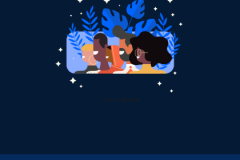
Blended learning for the Post-COVID era!
A year ago, we dreamed of the moment of getting back to our regular old lives and jump into those little life experiences to remember the taste of freedom, happiness… the taste of life. And Voilà, life starts to get back to normal in many parts of the world but with a different lifestyle and new habits. This COVID had brought new perspectives and changed the way we work, learn, and live.
But here we are living in a Newton Cradle: one ball is the COVID leftovers (anxiety, pain, fear), and the other is the desperate craving to get back to the usual joyful life.
This pandemic has forced us to adapt and engage in the massive usage of virtual platforms as a first-aid-plan to maintain continuity in work & education.

Hence the question: do we still need to rely on virtual platforms to teach and learn? Or get back to the traditional classes approach? Or rely on both?
Using a blend of learning approaches means combining different media types that complete each other to get the best outcome. This seems to be the most adequate learning approach as a post-COVID not only for universities and educational institutions but also for companies and business organizations.
In a recent research study done by the International Journal of Data and Network Science ( June 2021), Blended learning was defined as follows:
“Blended learning involves numerous approaches such as formal (teacher-led classrooms) and informal (e.g., role modeling and collegial connections) live face-to-face approaches, formal (live e-learning classes) and informal (e.g., emails and online communities) virtual collaborations, self-paced learning (e.g., online resource links, simulations, web-learning modules, online self-assessment, and workbooks), as well as performance support via knowledge databases, help systems, documentation, and performance support tools.”
So what does it take to implement a successful blended learning approach within your organization?
According to studies, 3 main success factors can influence a blended learning adoption;
- Human variables: competency to learn independently, experience with technological tools, learners preference of blended learning…
- Instructional variables: cost, time, effort, management support, learner support to ensure a high involvement…
- Learning variables: the presence of a clear learning strategy, technological and instructional support, awareness, and attitude toward blended learning …
How to plan, develop, deliver, manage and evaluate a blended learning program?
Referring to one of the milestones of blended learning, Khan’s octagonal blended learning framework, here are the 8 dimensions of this framework that serves to implement a meaningful well-distributed learning environment.
Khan’s blended learning framework
Why can an LMS be part of the blended learning technological facilitator?
LMS tools ( learning management systems) are commonly known for their anytime anywhere learning approach, where learners can attend their courses from any place at their own pace. This can help increase the learner’s acceptance and involvement in the blended learning approach, especially after “ flex-office” imposed by the new post-COVID lifestyle.
Another criterion of LMSs that can be a game-changer is the fact of supporting various content types. In its definition, blended learning is based on the use of different learning approaches and learning media and content types. Taking Smart Courses for Confluence LMS as an example, it supports almost every content type needed to design outstanding online courses, from adding customized questions to adding HTML codes.














